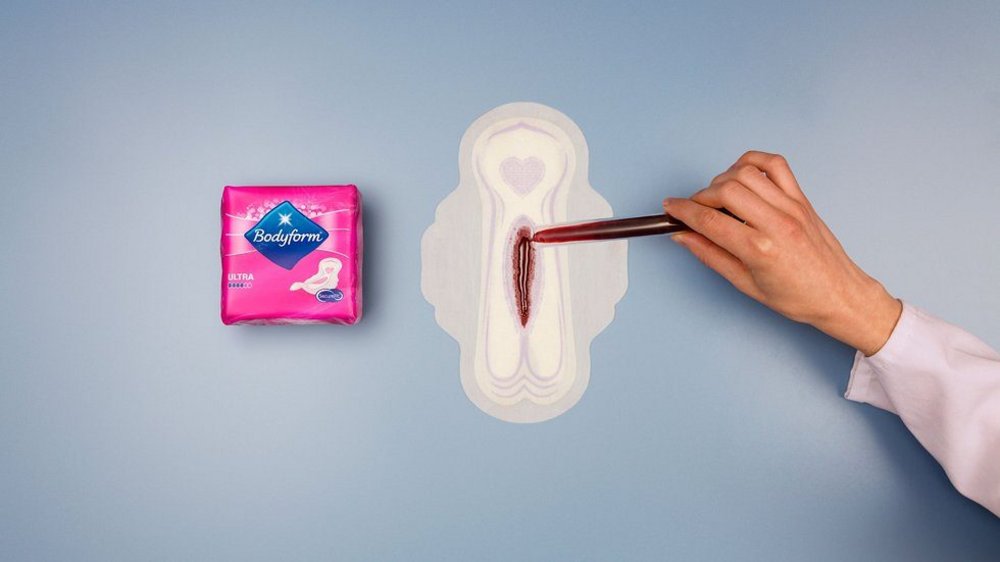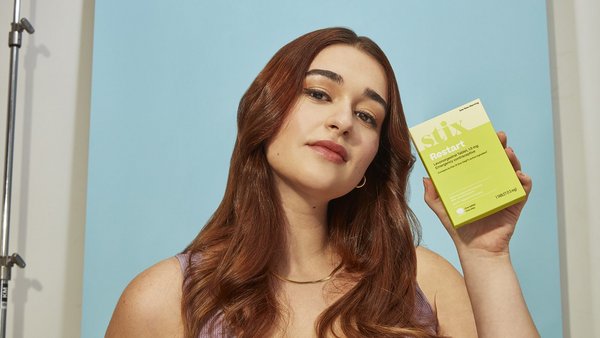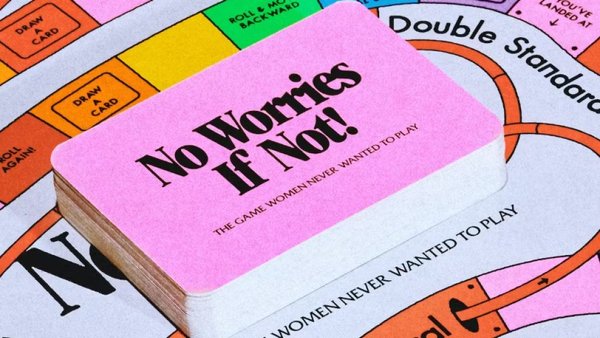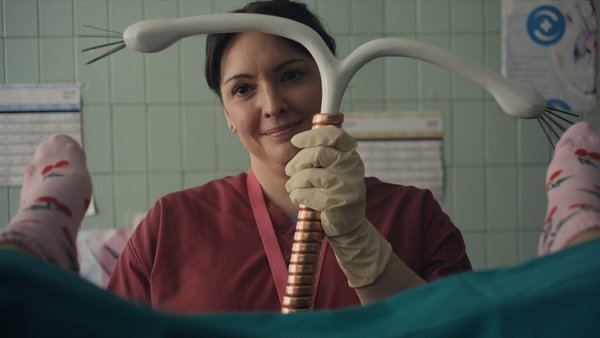Bodyform became the first feminine hygiene brand to show real period blood in an advert in its October campaign, Blood Normal. The Europe-wide campaign was created by London agency, Abbott Mead Vickers BBDO, and was led by a film that featured a montage of period-related scenes, such as a woman interrupting a dinner party to ask for a sanitary pad and a man buying tampons at a supermarket. The ad also replaced the clichéd blue-liquid demonstration with red liquid.
The idea behind the campaign was to present a world where periods were viewed as a part of everyday life, not a taboo subject.
We spoke with Martina Poulopati, a global brand manager at Essity (the company that owns Bodyform), to ask why the brand went after the feminine hygiene category’s conventions.
What is Bodyform’s positioning, as a brand?
With Bodyform it all started with The Truth, which was a big viral film we did in 2012. It became a global success and helped position Bodyform as a brand that has a different tone of voice and tackles period taboos head on.
Then in 2016 we launched three more campaigns across Europe that shared the aim of provoking conversation around periods: essentially that set the tone for Bodyform.
In the UK [Bodyform] is a challenger brand. It has a very limited marketing budget and very limited space on the shelf compared with the main competitor, Always, so it has to outsmart rather than outspend. These types of provocative communication have helped it have a larger share than its budget would allow.
The inspiration and the ambition was always there. Working in feminine care one of the first things you realise is that how many taboos are in this category and that most of the brands follow these norms. Bodyform was brave enough to be the first to break from that and from the huge response it was clear that there was something there for the brand.
Who are your main competitors?
More and more niche brands, but in terms of volume it’s Always. But now what we need to consider, apart from who is our main competitor in the category, is who are we competing against for share of consumers’ minds. Our comms operate mainly in the social and digital space and we’re competing with hundreds of brands, so that’s the real challenge.
A third of those polled had never seen a woman openly discuss her period in film or TV or books
Martina Poulopati, Essity
Does Bodyform target a specific demographic of women?
It can differ depending on the products, but I would say the main target audience we talk to globally is aged 18 to 35. There are, of course, specific programs, mostly educational, with younger audiences that we do about first periods.
What were the challenges that Bodyform was facing that gave rise to the brief for Blood Normal?
The limited marketing budget means we're always looking for opportunities to generate conversations in a cost-effective way. From a cost perspective, it’s also about making sure our plan reflects media consumption and is agile enough to respond to social and digital trends.
The task for the campaign as a whole was to break feminine hygiene conventions and create this inspiring campaign that enables women to live their lives. That came off the back of Red.Fit which was a big catalyst for change within [Essity] and gave us the first indication that if we tackle period taboos head on and break category norms we can have tremendous results.
With Red.Fit we saw an amazing consumer response and really strong reach, and over 90% of that came from earned media. We also saw brand equity grow in every country where the campaign was launched. That positive response gave us the encouragement to solidify breaking taboos as a strategy. And that was essentially the challenge, to continue breaking taboos and carry on the idea from Red.Fit.
What research informed the Red.Fit strategy?
Red.Fit was the first time that we decided to talk about the taboo of periods. It was something we felt we needed to do and we were looking at how to do it in a way that wouldn’t just be creating a lot of noise and doing nothing about it. With Red.Fit what we found through a survey we did in 2015 was that when women get their period it really affects their health habits. We also found that the majority of women didn’t know why they should keep fit during their periods so it gave us an opportunity to not just talk about it but give women information they could use.
What was the brief that produced the Blood Normal campaign?
The brief was quite open. It was about breaking category conventions with a campaign that enables you to live fearlessly, and one of the most important things was to follow the key line from Red.Fit – that no blood should hold us back. The next step from the brief was the research because it was really important that the campaign was built on a validated insight. So, one of the tasks was doing the survey and identifying the right territories but the general platform idea, that periods are largely absent from culture and we can do something to change that, was definitely in the back of our heads.
What insights did the research for the Blood Normal campaign throw up?
We did another online survey but this time opened it up, so we asked 10,000 men and women aged 13-50 years old across 10 countries all over the world. And what we found in that survey was that generally periods are a topic that is hushed up in every society and there were a lot interesting findings within that. For instance we found that a third of those polled had never seen a woman openly discuss her period in film or TV or books. We’re more likely to see blood in scenes of horror in popular culture than we are to see something as normal as a woman talking about her period. But what was clear was that a real desire to see that change. There was a large number, 74%, that said we want to see women in real situations in feminine hygiene. And a lot of this inspired the campaign and led us to Blood Normal.
In the UK we had a restricted version [of the ad] that was limited to 20 seconds and quite focused on moving from blue to red liquid, because that alone was a huge enough thing
Martina Poulopati, Essity
How did you get from the research to the Blood Normal creative concept?
The concept was really quickly uncovered. In the very first creative presentation from AMV we had that presented to us – which doesn’t happen very often, by the way – and we instantly loved the idea.
What was tricky about making the campaign?
We had to balance cultural sensitives and legal boundaries with this campaign, and very often these were formed by the taboos we were pressing against.
Some markets are more conservative than others. The way [this campaign] has been brought to life in Sweden with the long form video is much more elaborate and tackles many more taboos. In the UK we had a restricted version [of the ad] that was limited to 20 seconds and quite focused on moving from blue to red liquid, because that alone was a huge enough thing, and was deemed to be sufficient to drive the conversation. But in the long form there’s scene of pixilated blood at the end, this also reflects advertising regulations that we needed to follow.
We don’t want to offend or disrespect anyone, but we had to find a way of progressing and breaking taboos while driving a positive conversation and not just shocking people for the sake of shocking them.
How did you use media to launch the campaign?
Our small marketing budget means we work predominantly in PR, digital and social. The launch plan included consumer and creative PR; we did non-broadcast VOD, Facebook, Instagram and Twitter, and for the first time used Snapchat in the UK, which had good results for us. The plan reflects the media habits of our audience and the results were really great. In the first three weeks it generated 796 million in PR reach, 80 million social impressions and 6 million video views. We’ve seen similarly good performances coming out of Sweden, Denmark, Norway and the Netherlands, and hope to see it go live in other markets soon.
How does a campaign like this work on consumers to translate into sales?
You can't really link it to sales, but Red.Fit is a year old and has more comprehensive results. What we saw there, beyond reach and engagement, was that the brand equity pillars that we measure all had a boost. That means people are feeling closer to the brand. But what was interesting was we saw both the functional and emotional elements of the brand had an equally strong boost from the campaign. Even trial levels went up. So we do have early indications that this kind of provocative communication can support the brand and its growth on a sales level, too.
What lesson have you learned from the Blood Normal campaign?
I would say that if you’ve identified an important cause that’s right for your consumers and brand then be persistent and be there for the long run. I see a lot of brands that hop on the female empowerment wagon because they hope to get something out of it without being committed to it in the long run. Today’s consumers expect transparency and commitment – that takes a lot of persistence but can be extremely rewarding.










